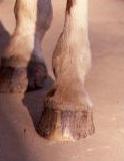Home > Horse Care > Hoof Care > Improving Hoof Quality
Improving Hoof Quality
- July 25, 2019
- ⎯ Equus
Question: Is there any proven method of improving hoof quality? My 10-year-old Thoroughbred has very weak feet that crack easily. He is constantly losing shoes and laid up as a result of his terrible hooves. I’ve been told to let him go barefoot for a year; I’ve been told that letting him go barefoot will only make things worse. I’ve heard the supplements and hoof dressings can help; I’ve been told supplements and hoof dressings are a waste of money. I’ve been told to only work him on hard ground; I’ve been told to work him in soft footing. Needless to say, I am confused. Is there any sure-fire way to improve the quality of my horse’s hooves?

Answer: Sadly, there is no universal, proven method for improving hoof quality, and some horses are so genetically deficient that they will never tolerate ordinary use with ordinary care. There are two principles in hoof conservation, however, which will encourage the best hoof growth that a particular horse’s genes will deliver in a given environment and with particular athletic demands:
The first principle: Keep everything consistent. Feed a balanced, primarily forage diet based on grassy or mixed hay and/or pasture and make no sudden changes to this diet. Also, keep the horse turned out on firm, well-drained pasture, with active herd mates, 24 hours a day, 7 days a week, 52 weeks a year. A shed and/or a windbreak will be sufficient protection from all but the most arctic cold. Finally, exercise the horse consistently. Increase the exercise level gradually and judiciously, always adjusting shoeing requirements well before (two to three months or two to three shoeings) a major increase.
The second principle: Apply the best farriery. Find a farrier who loves solving problems and has a record of success. He or she won’t come cheap, but it is money well-spent. Such a shoer may recommend one or more shoeless periods, depending on how your horse’s hooves are doing. Give this farrier a year or more to solve your problem-that is how long it takes for a horse to grow a new set of hooves. Follow the farrier’s instructions and timetable to the letter until/unless it is proven useless; Don’t “shop” for advice.
If your horse cannot perform adequately for you, even after following these principles faithfully for two years, there isn’t much else you can do but retire him and/or replace him with a better-footed one.








